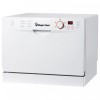Magic Chef MCSCD6W3 User Manual - Page 14
How To Load Items
 |
View all Magic Chef MCSCD6W3 manuals
Add to My Manuals
Save this manual to your list of manuals |
Page 14 highlights
OPTIMUM CAPACITY: Dishwasher Rack 1. Cups 2. Serving Bowls 3. Glassware 4. Saucers 5. Fruit Bowls 6. Oval PlaƩer 7. Dinner Plates 8. Bread/BuƩer Plates 9. Cutlery Basket HOW TO LOAD ITEMS: A) Locate sharp items so that they are not likely to damage the door seal. B) Do not load plasƟc items unless they are marked "Dishwasher Safe" or the equivalent. For plasƟc items without such markings, check the manufacturer's recommendaƟons. C) Cups, glasswares, and bowls must have their openings facing downwards in the dishwasher rack. D) Do not load glasswares over the dish rack pins. Glasses loaded over dish rack pins are not properly supported and are likely to get damaged. Certain types of glasses can become dull aŌer a large number of washes. E) Arrange all items with recessed or curved secƟons on a slant to drain water away from the items. F) Do not nest utensils together or overload the basket. They need to be evenly distributed. Make sure any cutlery items have not fallen through the basket, which can stop the spray arm from rotaƟng. G) Items with wooden or bone handles, and items joined together with glue are unsuitable for the dishwasher, as they cannot withstand the hot water used. H) Place silverware with handles facing down, with the excepƟon of knives and other potenƟally dangerous utensils which should have handles facing up. Do not load silverware with steel construcƟons that are subject to rusƟng. I) Do not load pewter or copper items, crystal glassware, wooden plaƩers, or items made from syntheƟc fibers. J) Silver and aluminium parts have a tendency to discolor aŌer washing. K) Glazed paƩerns may fade over Ɵme if they are frequently machine washed. -PAGE 13-















